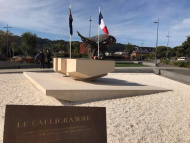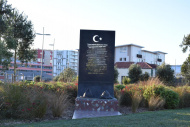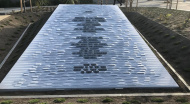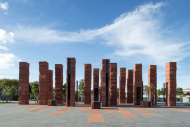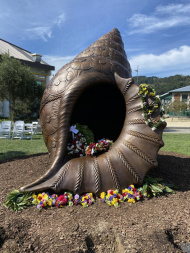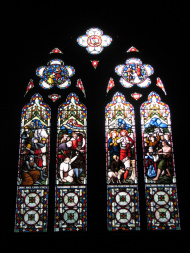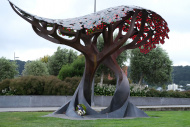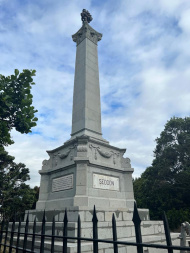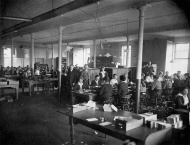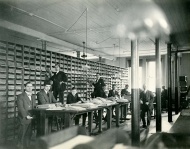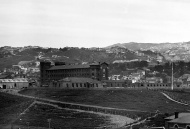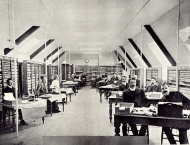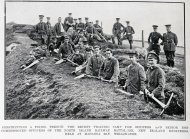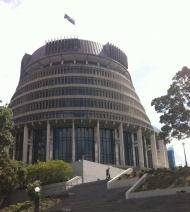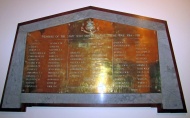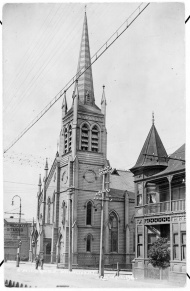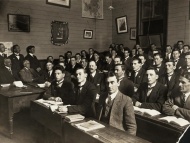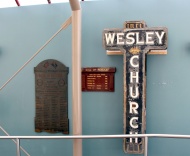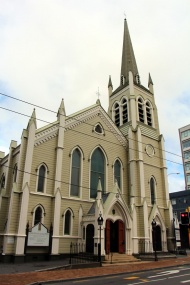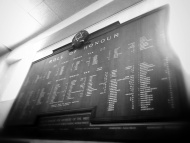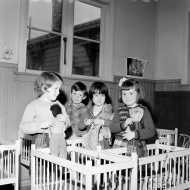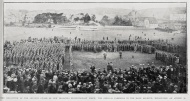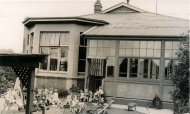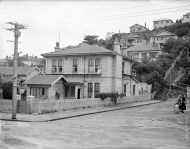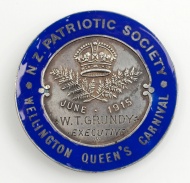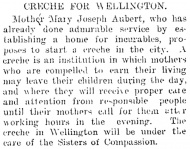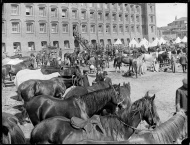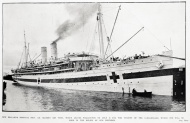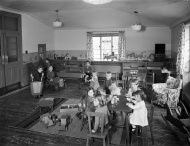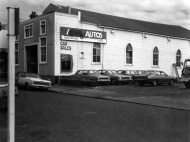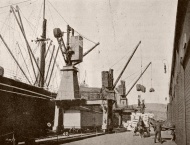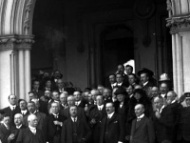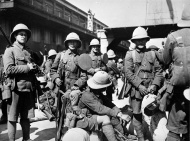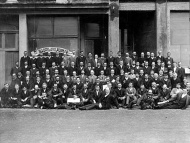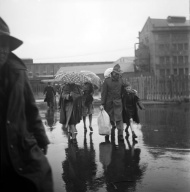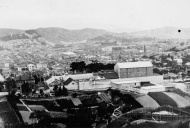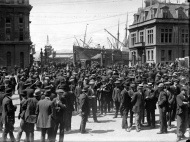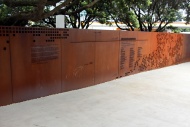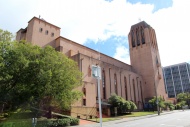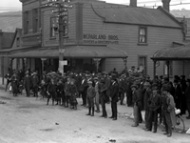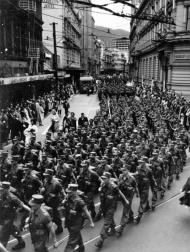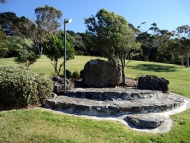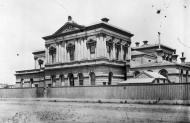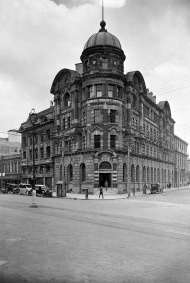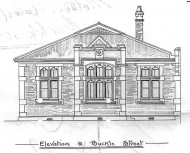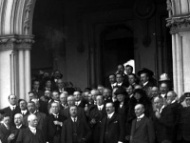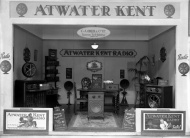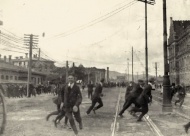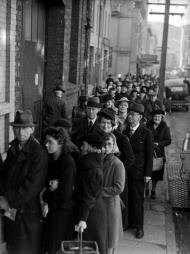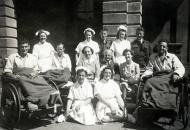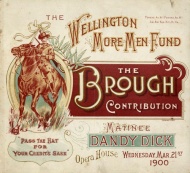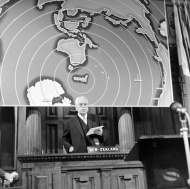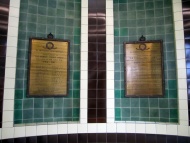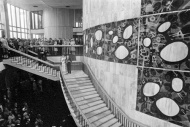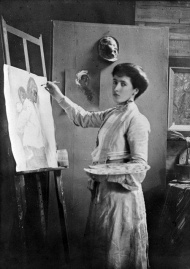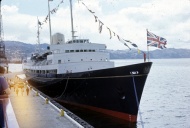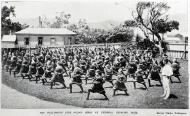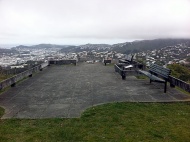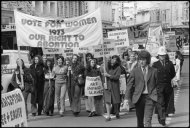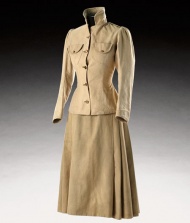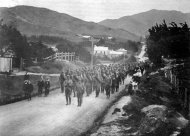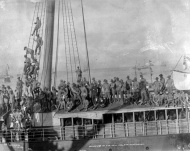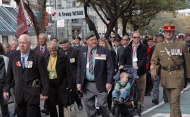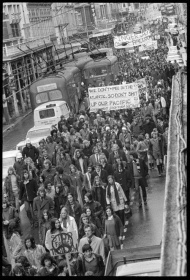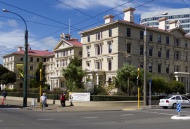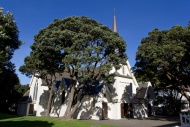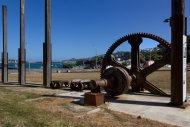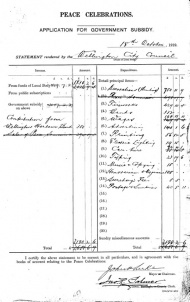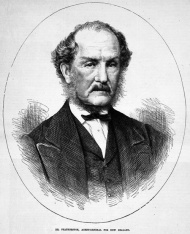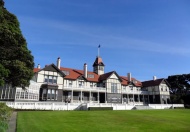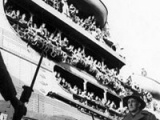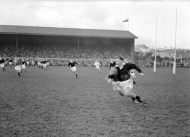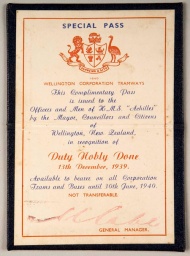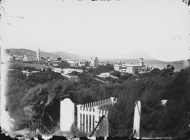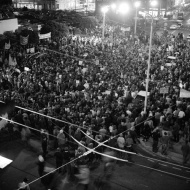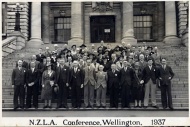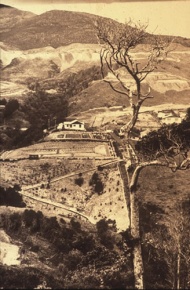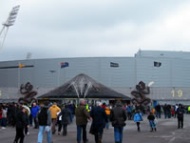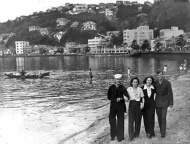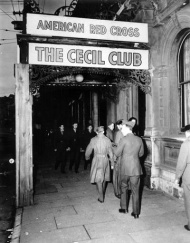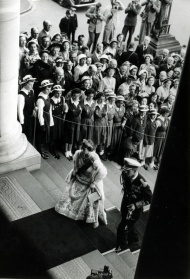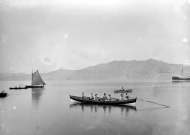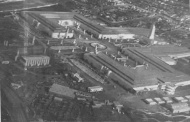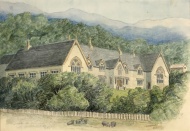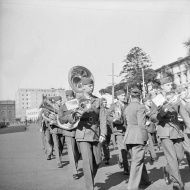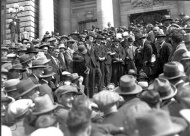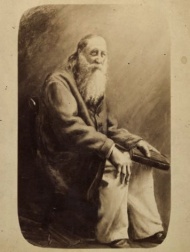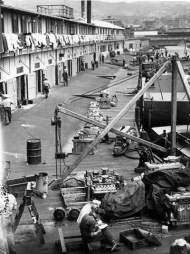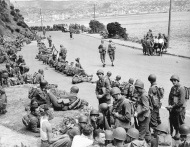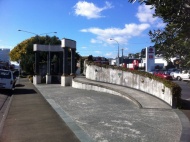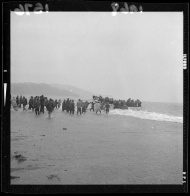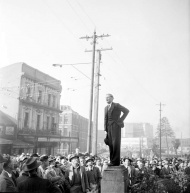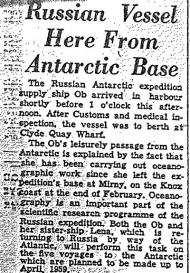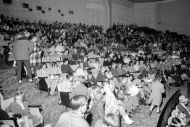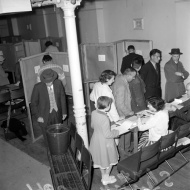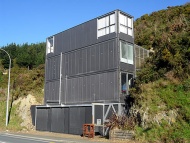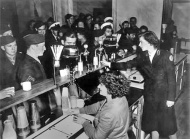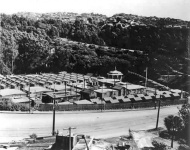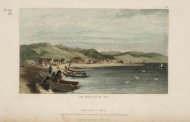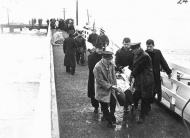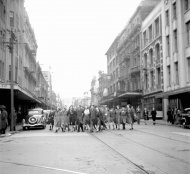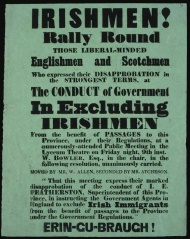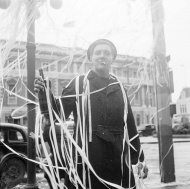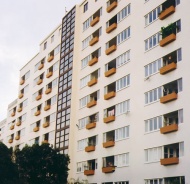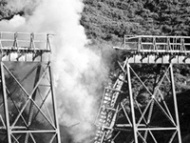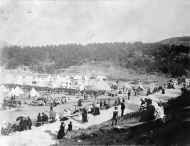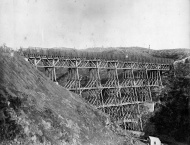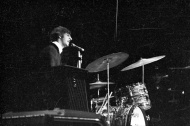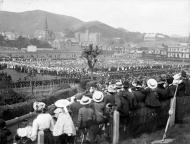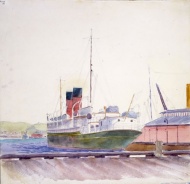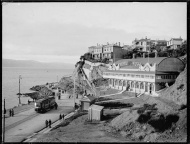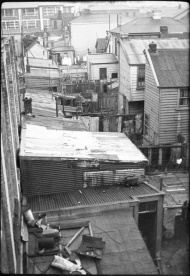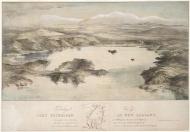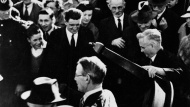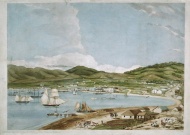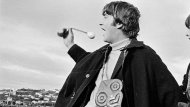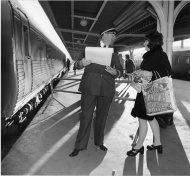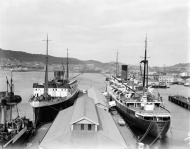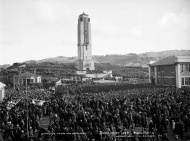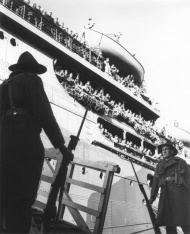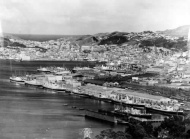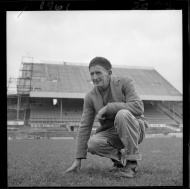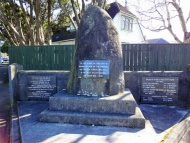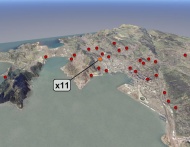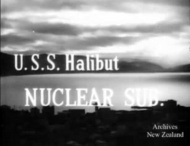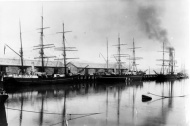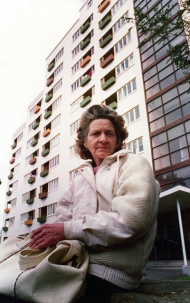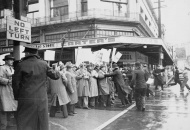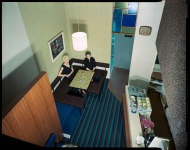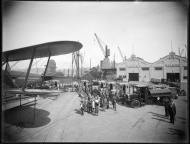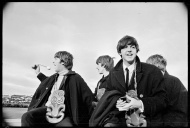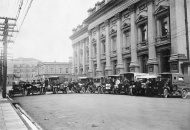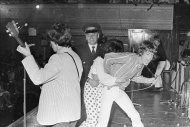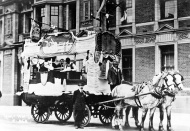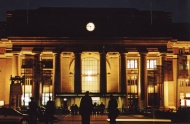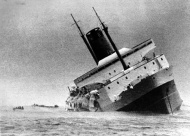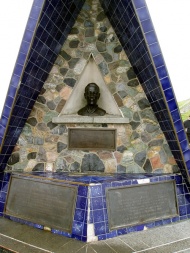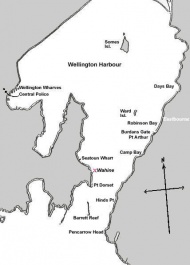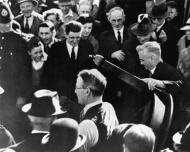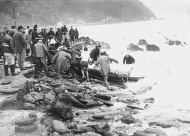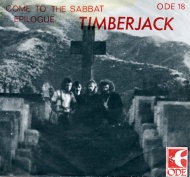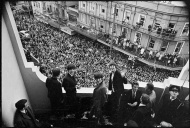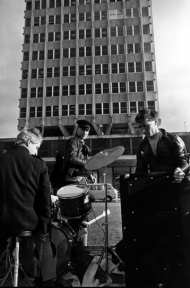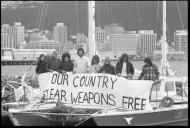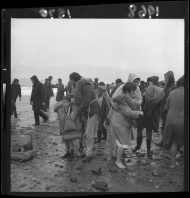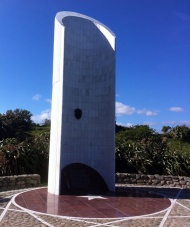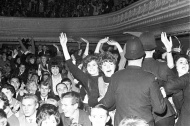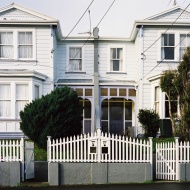Events In History
-
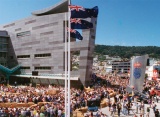 14 February 1998Te Papa museum opens
14 February 1998Te Papa museum opensNew Zealand’s new national museum, the Museum of New Zealand Te Papa Tongarewa, was officially opened on Wellington’s waterfront after a decade of planning and construction. Read more...
-
 23 November 1986Pope John Paul II celebrates Mass in windy Wellington
23 November 1986Pope John Paul II celebrates Mass in windy WellingtonThe first and so far only visit to New Zealand by a Bishop of Rome was significant for both Catholics and the wider community. Read more...
-
 15 February 1978New Zealand beats England in a cricket test for the first time
15 February 1978New Zealand beats England in a cricket test for the first timeChasing 137 for victory in the first test at the Basin Reserve in Wellington, England was bowled out for 64, with Richard Hadlee taking 6 for 26. Read more...
-
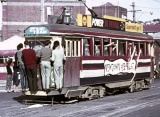 2 May 1964New Zealand's last electric tram trip
2 May 1964New Zealand's last electric tram tripTram no. 252, displaying the message ‘end of the line’ and driven by Wellington Mayor Frank Kitts, travelled from Thorndon to Newtown zoo. Large crowds lined the streets to witness the end of electric trams in New Zealand. Read more...
-
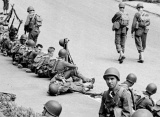 3 April 1943Battle of Manners Street
3 April 1943Battle of Manners StreetSoldiers and civilians slugged it out on the streets of Wellington during the ‘Battle of Manners Street’, the best-known clash between New Zealanders and American servicemen during the Second World War. Read more...
-
 8 November 1939New Zealand Centennial Exhibition opens
8 November 1939New Zealand Centennial Exhibition opensMore than 2.6 million people visited the New Zealand Centennial Exhibition, which ran for six months at Rongotai, Wellington. It was the centrepiece of the centennial of the signing of the Treaty of the Waitangi. Read more...
-
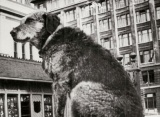 17 July 1939Death of Paddy the Wanderer
17 July 1939Death of Paddy the WandererPaddy, a ginger and brown Airedale terrier, became a national celebrity because of his exploits on the Wellington waterfront and beyond during the 1930s. Read more...
-
 2 February 1939Welfare plan gets baptism of fire
2 February 1939Welfare plan gets baptism of fireA massive fire destroyed the nearly completed three-storey Social Security building. Just seven weeks later, a replacement building was opened by Prime Minister Michael Joseph Savage. Read more...
-
 16 June 1923Baby-farmer Daniel Cooper hanged
16 June 1923Baby-farmer Daniel Cooper hangedA generation after the hanging of the infamous Minnie Dean, the murder trial of Daniel and Martha Cooper revealed that ‘baby farming’ and illegal abortion were still regarded as solutions to the problem of unwanted children in New Zealand. Read more...
-
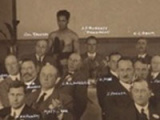 7 June 1921First Rotary club in New Zealand founded
7 June 1921First Rotary club in New Zealand foundedA local Rotary club was established at a luncheon in Wellington’s YMCA, with Alexander Roberts elected as the first president. Read more...
-
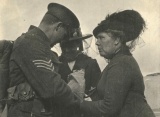 16 October 1914Main Body of NZEF sails to war
16 October 1914Main Body of NZEF sails to warThousands of Wellingtonians rose before dawn and crowded vantage points around the harbour to watch as 10 grey-painted troopships, escorted by four warships, sailed to war. Read more...
-
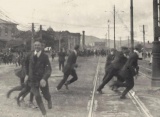 5 November 1913Battle of Featherston Street
5 November 1913Battle of Featherston StreetThe ‘Battle of Featherston Street’, in downtown Wellington, saw some of the most violent street fighting of the 1913 Great Strike. Read more...
-
 9 June 1909Public Trust Office building opens
9 June 1909Public Trust Office building opensPrime Minister Sir Joseph Ward opened the Public Trust Office Building in Lambton Quay, Wellington. The occasion was marked by a lunchtime banquet and a concert and dance that evening Read more...
-
 24 September 1905Racist killing in Wellington's Haining St
24 September 1905Racist killing in Wellington's Haining StThe murder of retired miner Joe Kum Yung by white supremacist Lionel Terry in Wellington’s Haining Street highlighted the hatred some felt towards New Zealand’s small but long-established Chinese community. Read more...
-
 27 August 1904Foundation stone for Victoria University’s first building laid
27 August 1904Foundation stone for Victoria University’s first building laidVictoria College (now Victoria University of Wellington) was founded in 1897 to mark Queen Victoria's 60th jubilee. Until the opening of the Kelburn building in 1906, classes were taught in rented rooms. Read more...
-
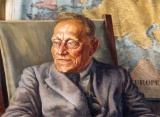 22 March 1902George von Zedlitz arrives in Wellington
22 March 1902George von Zedlitz arrives in WellingtonVictoria College’s first professor of modern languages joined the fledgling institution’s four foundation professors. Read more...
-
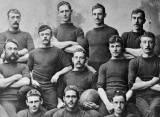 22 May 1884First New Zealand rugby team in action
22 May 1884First New Zealand rugby team in actionThe first representative New Zealand rugby team played its first match, defeating a Wellington XV 9-0 before embarking on a tour of New South Wales. Read more...
-
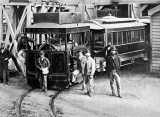 24 August 1878Wellington steam-tram service opened
24 August 1878Wellington steam-tram service openedThe governor, the Marquess of Normanby, formally opened the new service, which was said to be the first in the southern hemisphere. Read more...
-
 26 July 1865Parliament moves to Wellington
26 July 1865Parliament moves to WellingtonThe capital moved from Auckland to more centrally located Wellington on the recommendation of an Australian commission. The former Wellington Provincial Council chamber became the new home for Parliament. Read more...
-
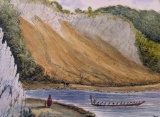 23 January 1855Massive earthquake hits southern North Island
23 January 1855Massive earthquake hits southern North IslandThe magnitude 8.2 earthquake had a profound impact on the development of Wellington city. Read more...
-
 26 February 1844'Pistols at dawn': deadly duel in Wellington
26 February 1844'Pistols at dawn': deadly duel in WellingtonWilliam Brewer died of wounds received during a pistol duel with another Wellington lawyer, H. Ross, on 26 February 1844. The duel followed a quarrel over a case in the Wellington County Court. Read more...
-
 31 July 1843Foundation stone laid for New Zealand's first purpose-built theatre
31 July 1843Foundation stone laid for New Zealand's first purpose-built theatreLaying the foundation stone for the Royal Victoria Theatre on Manners St, Wellington, Alderman William Lyon welcomed the new amenity – ‘a theatre [was] a necessary concomitant of an advanced state of civilization.’ Read more...
-
 18 April 1840Samuel Revans prints first newspaper
18 April 1840Samuel Revans prints first newspaperThe first newspapers published in New Zealand were printed by Samuel Revans a month after he arrived in Port Nicholson (Wellington). Read more...
-
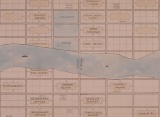 22 January 1840European settlers arrive in Wellington
22 January 1840European settlers arrive in WellingtonThe New Zealand Company's first settler ship, the Aurora, arrived at Petone to found the settlement that would become Wellington. Read more...

Te Āti Awa leader Wiremu Tako Ngātata was one of the first Māori members of the Legislative Council. He opposed legislation threatening Māori possession of land.
Read more...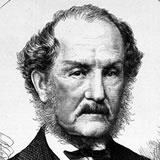
A stalwart of Wellington political life, Featherston served as provincial Superintendent and later served as a member of the House of Representatives, colonial secretary and minister without portfolio.
Read more...
Colonel William Wakefield was one of the earliest European settlers at Port Nicholson (Wellington), where he served as the New Zealand Company’s Principal Agent between 1840 and 1848.
Read more...Articles
Wellington cafe culture

Café culture has become integral to Wellington's identity. This culture began in the 1930s with the emergence of the milk bar, followed by coffee houses in the 1950s. After a period of decline in the 1960s and 70s, the city's café scene has grown in spectacular fashion over the last 20 years.
-
Page 2 – Overview
Wellington city centre is renowned for its flourishing café scene and the culture it inhabits. But it was nearly 1950 before there was much sign of the sparkling capital
-
Page 3 – Immigration and Society
The rise of coffee houses in the 1940s, 50s and 60s was not a phenomenon confined to Wellington, or indeed to New Zealand. The connection between the history of cafe
-
Page 4 – Design and technology
New construction materials and equipment fashioned the cafe culture rising in the 1950s. Wellingtonians were introduced to the espresso machines as European styled cafes
-
Page 5 – Music and cafe culture
Entertainment generally and music in particular have always been a part of the Wellington cafe scene.
-
Page 6 – Personalities
New Zealand in the 1940s and 1950s has been described as a drab and uniform place. From the late 1950s, however, a café culture was established throughout the country.
-
Page 7 – Further information
Sources on Wellington cafe culture.
Parliament Buildings
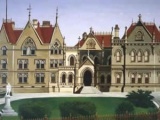
Parliament buildings have been modified, destroyed by fire, half-built and restored; the parliamentary places and spaces have formed an important part of New Zealand's history.
-
Page 2 – First Parliament buildings
Auckland was a bustling place in 1854 when Parliament met there for the first time. The buildings were located in paddocks on what was then the edge of town, Constitution Hill
The Beatles in New Zealand
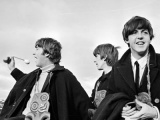
When four young Liverpool musicians landed in Wellington on a lazy Sunday afternoon in June 1964, seven days of pandemonium erupted. Young New Zealanders flocked in their thousands to hear or just catch a glimpse of the famous 'Fab Four'.
-
Page 3 – Wellington
Seven thousand screaming fans waited as The Beatles touched down at Wellington airport on 21 June 1964. As the band stepped off the plane, the fans' shrieks drowned out the
Wahine disaster
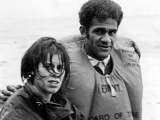
This April marks the 45th anniversary of the sinking of the ferry Wahine. With more than 50 lives lost, this was New Zealand's worst modern maritime disaster. The Wahine’s demise on 10 April 1968 also heralded a new era in local television, as pictures of the disaster were beamed into living rooms around the country.
-
Page 2 – Timeline to tragedy
The events that led to the drowning of 51 people in the Wahine disaster of 10 April 1968
-
Page 3 – Co-ordinating the rescue
The police, emergency services and civilians rescued passengers and crew from the inter-island ferry Wahine in Wellington Harbour in April 1968.
War in Wellington
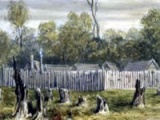
In 1846 fighting broke out in the Wellington region when Ngāti Toa chief Te Rangihaeata backed local Maori opposed to European settlement in Hutt Valley. The campaign claimed few lives but effectively ended Ngāti Toa resistance in the region.
-
Page 2 – The Port Nicholson purchase
In September 1839 William Wakefield, the principal agent for the New Zealand Company, met Te Ātiawa chiefs Te Puni and Te Wharepōuri at Pito-one (Petone), on the northern shore
-
Page 3 – Return to Hutt Valley
It was soon apparent that Wellington did not have enough flat fertile land. Attention turned back to the lower Hutt Valley as the best location for an agricultural settlement
-
Page 7 – Political prisoners
Te Rauparaha became one of New Zealand’s first political detainees when he was seized during the fighting in Hutt Valley in 1846.
Capital 150
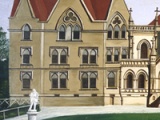
Ever since 1865, Wellington’s identity has been inextricably linked to its role as the seat of central government.
- Page 1 - Capital 150Ever since 1865, Wellington’s identity has been inextricably linked to its role as the seat of central
A sense of place
Stories in the land field trip
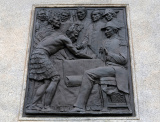
Field trips are a fantastic way for students and teachers to develop shared experiences outside of the classroom. This field trip – ‘Stories in the land’ – is facilitated by educator-historian Ricky Prebble and can be adapted for senior and junior students.
- Page 1 - Stories in the land field tripField trips are a fantastic way for students and teachers to develop shared experiences outside of the classroom. This field trip – ‘Stories in the land’ – is facilitated
Hidden streams field trip
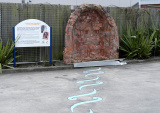
Field trips are a fantastic way for students and teachers to develop shared experiences outside of the classroom. This field trip has been run successfully with Year 9 Social Studies students in the past.
- Page 1 - Hidden streams field tripField trips are a fantastic way for students and teachers to develop shared experiences outside of the classroom. This field trip has been run successfully with Year 9 Social
US Forces in New Zealand
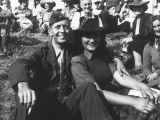
The first American soldiers landed on New Zealand soil in June 1942, beginning an 'invasion' which would have a profound impact on both visitors and hosts over the next 18 months.
- Page 3 - Arrival The ‘invasion’ began in Auckland on 12 June 1942, when five transport ships carrying soldiers of the US Army sailed into Waitematā Harbour. Two days later, Marines landed in
Housing the Prime Minister
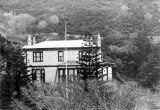
Almost 150 years after the government purchased the first official premier's residence on Tinakori Road, Wellington, the address of Premier House remains the same. But in the intervening years the building has been extended, renamed, abandoned and refurbished.
- Page 2 - The first premier houseOur first premiers had to find their own digs. That changed in 1865, when the government bought the premier a simple 22-year-old wooden cottage in Thorndon’s Tinakori
The House of Representatives
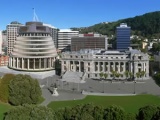
New Zealand's Parliament dates back to 1854, just 14 years after the signing of the Treaty of Waitangi and the beginning of the European settlement of the country. For most of its history as a nation state, New Zealand has had some form of elected government.
- Page 6 - First sitting, 1854It started with a bang – 21 in fact, fired from the guns at Auckland's Fort Britomart. As soon as the smoke had cleared, New Zealand's first Parliament was under
The 1913 Great Strike
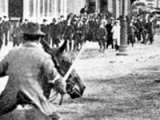
The Great Strike of 1913 was in fact a series of strikes between mid-October 1913 and mid-January 1914. It was one of New Zealand’s most violent and disruptive industrial confrontations.
-
Page 4 – The 1913 strike in Wellington
Because the strike threatened their livelihoods, rural men were keen to volunteer as special constables.
Regional rugby

The passion and parochialism of provincial rugby helped give the game a special place in New Zealand’s social and sporting history. Read brief histories, highlights and quirky facts about each of New Zealand's 26 regional rugby teams.
- Page 20 - Wellington rugbyHistory and highlights of rugby in the Wellington
Related keywords
- national war memorial
- france
- turkey
- united states
- belgium
- australia
- sportswomen
- football
- pacific peoples
- church
- taranaki
- new zealand wars
- united kingdom
- richard seddon
- prime ministers
- public service
- WW1 home front
- peace celebrations
- roll of honour
- conscription
- basin reserve
- government
- railways
- gallipoli campaign
- willochra
- victoria cross
- wellington harbour
- 1913 strike
- education
- miramar
- weslyans
- methodism
- anglican
- protest
- carillon
- edward gibbon wakefield
- william wakefield
- treaty of waitangi
- chinese
- religion
- child welfare
- children
- german samoa occupation
- WW1
- fundraising
- theatre
- film
- television
- shipping
- mary aubert
- salvation army
- workers rights
- maheno (hospital ship)
- hospital ships
- railway stations
- south african war
- radio broadcasts
- maori contingent
- maori in war
- newspapers
- trade unions
- WW2
- furlough
- hms philomel
- prisoners of war
- coastwatchers
- postal service
- chunuk bair
- william malone
- memorials
- wellington high school
- malayan emergency
- cold war
- hataitai
- architecture
- 1920s
- karori
- rationing
- nurses
- WW1 stories
- sport
- athletic park
- american forces
- boer war
- vietnam war
- SEATO
- international relations
- walter nash
- victoria university
- navy
- royal new zealand navy
- auckland city
- huntly
- coal mining
- red feds
- catholic
- parliament buildings
- beehive
- 1970s
- royalty
- museums
- island bay
- second contingent
- war art
- frances hodgkins
- art
- art history
- lower hutt
- petone
- centennial
- pioneers
- historic places
- printing
- queen elizabeth
- britannia
- transport
- demonstrations
- exercise
- physical education
- air force
- DDay
- james stellin
- royal air force
- womens liberation
- women
- uniforms
- war objects
- first contingent
- housing
- julius vogel
- frederick weld
- premiers
- joseph ward
- newtown
- container shipping
- parades
- leisure
- food
- cafes
- drink
- centennial exhibition
- rongotai
- social policy
- michael joseph savage
- thorndon
- nuclear free
- whanganui river
- battle hill
- te umuroa
- hutt valley
- cricket
- trams
- music
- beatles
- carmen
- universities
- isaac featherston
- governor-general
- home front
- marines
- rugby
- ron jarden
- libraries
- famous firsts
- port nicholson
- refugees
- hotel
- battle of the river plate
- HMS Achilles
- scenery
- roadside stories
- dance
- oriental bay
- red cross
- parliament
- royal tours
- rowing
- aerial photography
- upper hutt
- wellington wars
- painting
- great depression
- bookshops
- guadalcanal
- dominion day
- don peebles
- abstract art
- aquitania
- frederick knox
- battle for crete
- duelling
- william brewer
- disasters
- wahine disaster
- seatoun
- frank kitts
- 1960s
- strikes
- waterfront dispute
- antarctica
- russia
- movies
- bellamys
- governor
- voting
- elections
- cartoon
- milk bars
- brooklyn
- pencarrow head
- MPs
- doctors
- new zealand company
- botany
- maori pa
- police
- anzac day
- public holidays
- wellington cenotaph
- pacific war
- economy
- terrace school
- VJ day
- immigrants
- irish
- legislative council
- te ati awa
- wi tako
- maori leaders
- celebration
- dominion of new zealand
- seafarers
- state housing
- flats
- roading
- 1950s
- immigration
- assisted immigration
- christmas
- anniversaries
- crime
- daniel cooper
- newlands
- ferries
- war memorials
- poverty
- charles heaphy
- alcohol
- settlers
- trains
- VE day
- william massey
- boulcotts farm
- NZ Wars memorial
- western front
- wellington college
- passchendaele offensive
- casualties
- nuclear ships
- americans
- lyttelton
- robert scott
- port chalmers
- richard byrd
- kororareka
- george grey
- air transport
- influenza pandemic
- health
- rolling stones concert
- labour day
- labour party
- music month
- murder
- racism
- maps
- springboks
- punk
- TVNZ
- earthquakes
- battle of messines
- medals
- fat freddys drop
- kemal ataturk
- cook strait
- eastbourne
- broadcasting
- dunedin
The New Zealand Company chose Wellington as its first organised settlement in 1839. Its future was uncertain until 1865 when it was chosen as the colony’s new capital. Alongside the shift in the seat of government was the centralisation of businesses – many major firms set up their head offices in Wellington. From the 1990s Wellington has rebranded itself as the country’s creative capital.


